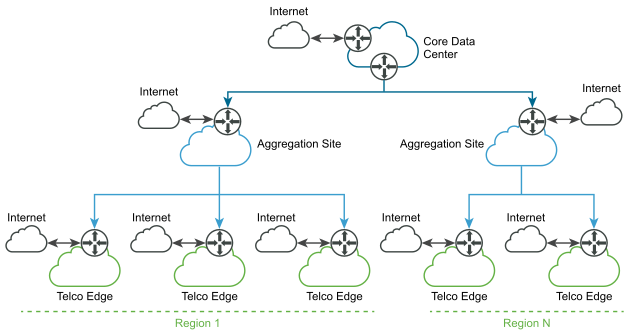The Telco Edge is a collection of distributed virtual infrastructure deployments that can be used to run Telco workloads (such as VNFs) and other user applications. The Edge Reference Architecture provides the flexibility depending on the nature of the workloads and applications, the position in the network, the size of the deployment, and the software-defined infrastructure model.
A classic 3-layer conceptual architecture for the Telco Edge deployment is a hierarchical model that consists of a group of Telco Edges that form an Aggregation site and a group of Aggregation sites that form a Core data center.

Telco Edge
Customer edges connect at the “last mile” to cell towers or wireline aggregation points that are the Telco Edge Sites. The number of servers and the types of Telco network functions, such as virtualized RAN (vRAN) and applications (AR/VR) are constrained by deployment locations, power, cooling, or network factors. Internet “breakout” allows the applications deployed on the Telco Edge to access the Internet directly without having the traffic backhauled to the Aggregation Site or regional/core location.
Aggregation Site
The next level of the hierarchy is the Aggregation site, which aggregates traffic from multiple Telco Edges and generally has fewer constraints related to capacity. The aggregation site consists of a large number of servers with high capacity to run applications. A repurposed central office in the wireline scenario is an example of an Aggregation site deployment location. An Aggregation site can contain multiple racks in a typical deployment. Latencies from the user equipment to the Aggregation site are in the range of 5-10 milliseconds but can vary depending on the deployment. An Internet breakout is also present in this deployment.
The aggregation functionality can involve a separate management plane installation to manage Telco edges for scalability requirements. Sometimes, the Aggregation site is only used to run applications, while the management functionality for both the Telco Edges and Aggregation site is instantiated in a Core data center.
Core Data Center
The final level of the hierarchy is the Core Data Center that acts as a centralized location for aggregating all control and management plane components for a given region. This deployment is similar to the current centralized model used in Telco networks where the core runs VNF functions and other applications. In the 5G world, the 5G Control Plane (CP) functions are run in the Core data center and the User Plane (UP) functions are run in the edges.
The maximum number of Edge sites in a specific group is governed by the maximum scale supported by the respective management components. In addition to functioning as a traffic aggregation point, a higher layer site also functions as a management layer for the lower tiers, as appropriate. Therefore, the management component for all the Telco Edges aggregating into an Aggregate site is usually located in the specific Aggregate site, in this case, the Core Data Center.